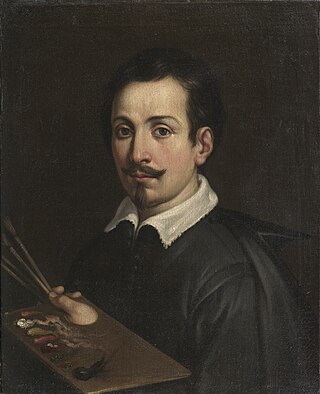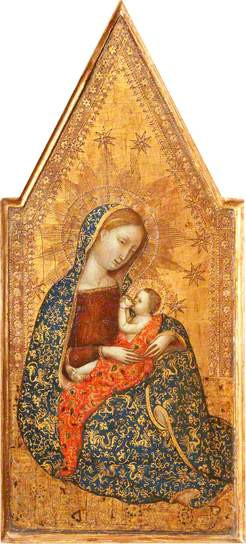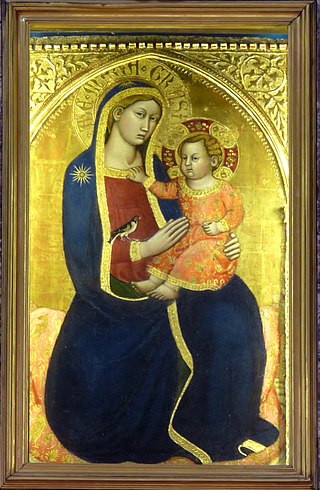
Lorenzo Lotto was an Italian Renaissance painter, draughtsman, and illustrator, traditionally placed in the Venetian school, though much of his career was spent in other north Italian cities. He painted mainly altarpieces, religious subjects and portraits. He was active during the High Renaissance and the first half of the Mannerist period, but his work maintained a generally similar High Renaissance style throughout his career, although his nervous and eccentric posings and distortions represented a transitional stage to the Florentine and Roman Mannerists.

Guido Reni was an Italian painter of the Baroque period, although his works showed a classical manner, similar to Simon Vouet, Nicolas Poussin, and Philippe de Champaigne. He painted primarily religious works, but also mythological and allegorical subjects. Active in Rome, Naples, and his native Bologna, he became the dominant figure in the Bolognese School that emerged under the influence of the Carracci.

Pinturicchio, or Pintoricchio, also known as Benetto di Biagio or Sordicchio, was an Italian Renaissance painter. He acquired his nickname because of his small stature and he used it to sign some of his artworks that were created during the fifteenth and sixteenth centuries.

Carlo Cignani was an Italian painter. His innovative style referred to as his 'new manner' introduced a reflective, intimate mood of painting and presaged the later pictures of Guido Reni and Guercino, as well as those of Simone Cantarini. This gentle manner marked a break with the more energetic style of earlier Bolognese classicism of the Bolognese School of painting.

Vincenzo Foppa was an Italian painter from the Renaissance period. While few of his works survive, he was an esteemed and influential painter during his time and is considered the preeminent leader of the Early Lombard School. He spent his career working for the Sforza family, Dukes of Milan, in Pavia, as well as various other patrons throughout Lombardy and Liguria. He lived and worked in his native Brescia during his later years.

Carlo Maratta or Maratti was an Italian painter, active mostly in Rome, and known principally for his classicizing paintings executed in a Late Baroque Classical manner. Although he is part of the classical tradition stemming from Raphael, he was not exempt from the influence of Baroque painting and particularly in his use of colour. His contemporary and friend, Giovanni Bellori, wrote an early biography on Maratta.

San Ginesio is a comune (municipality) in the Province of Macerata in the Italian region Marche, located about 60 kilometres (37 mi) southwest of Ancona and about 25 kilometres (16 mi) southwest of Macerata. As of December 31, 2004, it had a population of 3,872 and an area of 77.7 square kilometres (30.0 sq mi).

Jacopo da Empoli was an Italian Florentine Reformist painter.

Antonio d'Enrico, called Tanzio da Varallo, or simply il Tanzio was an Italian painter of the late-Mannerist or early Baroque period.

Filippo Abbiati (1640–1715) was an Italian painter of the early-Baroque period, active in Lombardy and Turin, together with Andrea Lanzani and Stefano Maria Legnani, he was a prominent mannerist painters from the School of Lombardy. Born in Milan, he was a pupil of the painter Antonio Busca. Alessandro Magnasco was one of his pupils along with Pietro Maggi and Giuseppe Rivola. Ticozzi claims he trained, along with Federigo Bianchi, with Carlo Francesco Nuvolone. Along with Bianchi, he painted the cupola of Sant'Alessandro Martire in Milan. Abbiati also painted a St. John preaching in the Wilderness for a church in Saronno.

Niccolò di Ser Sozzo was an Italian painter and manuscript illuminator. He generally has been identified as Niccolò di Ser Sozzo di Francesco Tegliacci, but recent research points instead to a Niccolò di Ser Sozzo di Stefano. Whatever his true identity, Niccolo was one of the leading panel painters and miniaturists at work in Siena in the mid-14th century. His style is closest to that of Lippo Vanni and his sometime collaborator Luca di Tomme and is ultimately dependent upon the tradition of Simone Martini and, especially, the Lorenzetti brothers, in whose workshop he may have apprenticed.
Simone de Magistris was an Italian painter and sculptor.

Lorenzo d’Alessandro was an Italian painter and interpreter of late gothic style. He is known by different authorities and authors by different names, including:

Giovanni Agostino da Lodi was an Italian painter who was active from c. 1495 to c. 1525.

Francescuccio Ghissi, also called Francesco di Cecco Ghissi, was an Italian painter. His exact date of birth and death are not known.

Jacopo di Michele, also called Jacopo Gera, Iacopo di Michele, or Gera da Pisa is a 14th-century painter, active mainly in Pisa and elsewhere in Tuscany, in a Gothic style. His activity is documented from 1361 to 1395. He is the brother of Getto di Jacopo

The Pinacoteca Civica Padre Pietro Tacchi Venturi is the civic art gallery of the town of San Severino Marche, region of Marche, Italy. Located at Via Salimbeni 39, it mainly displays sacred paintings from prior centuries.

Nicola di Ulisse, also known as Nicola da Siena or Nicola di Ulisse da Siena was an Italian painter of the Umbro-Sienese school.

The Master of San Verecondo was an anonymous painter active in the towns of Fabriano and Gualdo Tadino in the Marche.
The Master of Staffolo was an anonymous late-Gothic style painter active in the region of Marche and Umbria.


















